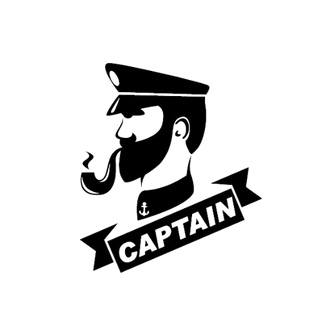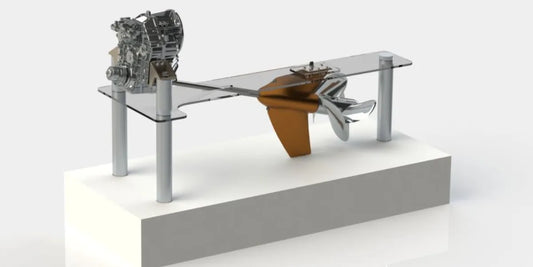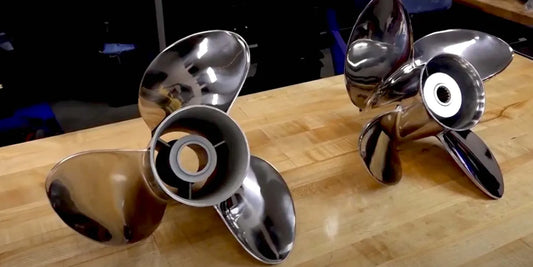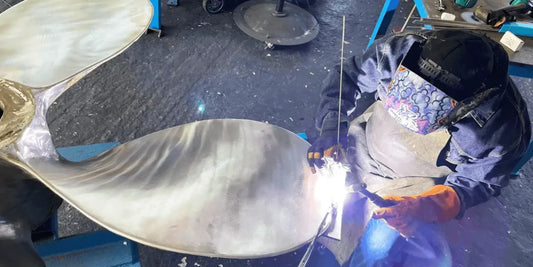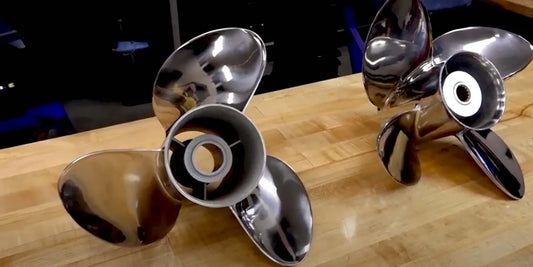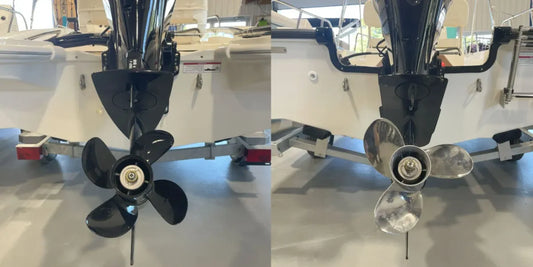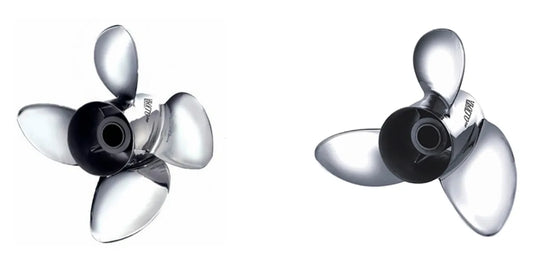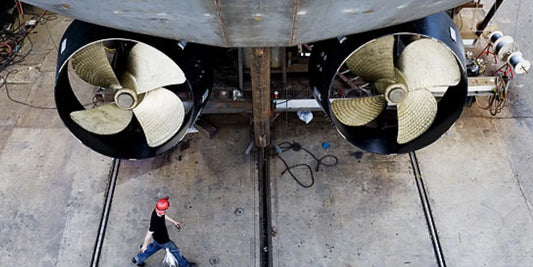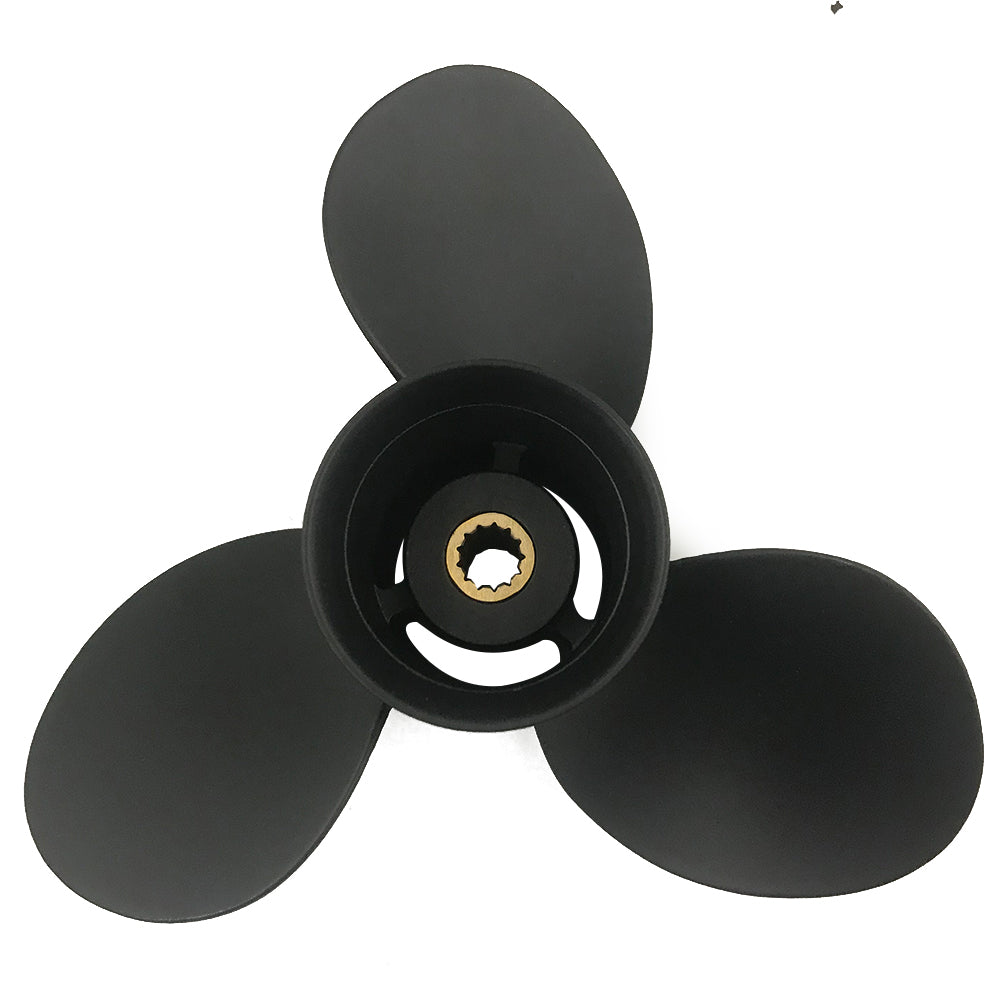Boaters know how a propeller in good shape makes all the difference in achieving peak performance on the water. Whether to achieve better fuel economy, gain speed, or avoid future repair costs, knowing the basics about propeller care and repair is vitally important. This article focuses on important tips for diagnosing issues, working on repairs, and extending the life of a propeller. Equipped with the knowledge from this article, you'll be able to maintain your boat further smoothly, thus making every trip go with ease.
Understanding Propeller Damage

Common Causes of Propeller Damage
Propeller damage can arise from various factors, which are mostly preventable with proper care and mindfulness. The most frequent ones involve going aground or bumping into underwater obstacles such as rocks, debris, or sandbars. This can cause bending of the blades, cracking, or other forms of deformation, thus impairing its function through vibration during operations.
Cavitation is another major cause. Cavitation may start as the formation of air bubbles around the propeller blades, caused by turbulence and improper alignment. Chronic cavitation damages these blades by erosion, hence slowly affecting their performance and integrity.
Corrosion is also a significant problem caused by prolonged exposure to the corrosive action of saltwater or electrochemical reactions, especially when propellers lack adequate protection. Aluminum or stainless steel propellers are mainly affected. If allowed to go unchecked, corrosion can weaken the propeller and cut down its lifespan.
Improper maintenance is the other factor; failure to clean and inspect the propeller regularly, or neglecting to examine the alignment and tightening of the propeller hub will instead expedite wear and tear. By identifying these causes and implementing preventive measures early on, protective steps can be taken, thereby securing their investment and ensuring continued performance for an extended period.
Identifying Signs of Damage
Early identification of signs of propeller damage is necessary to ensure performance and prevent repairs at exorbitant costs. One main sign could be the boat slowing down or losing acceleration, given that the engine runs perfectly well; this might indicate physical damage, bent or chipped blades, that interfere with propeller efficiency. Other indications, such as peculiar vibrations or loud noises during operations, could be signs of an imbalance or material fatigue in the propeller.
Visual observation for detecting damage becomes pivotal. Cracks, corrosion, and deformation stress the propeller's structure and affect its hydrodynamics. Discoloration or pitting can mark the onset of corrosion, most probably in saltwater. Another sign of possible damage could be unusual spray patterns from the water behind the boat, suggesting uneven blade surfaces or something out of alignment.
The periodic check for these signs ensures good boat performance and lengthens the lifespan of your propeller. Paying attention to maintenance and repair as soon as damage is detected will prevent it from worsening, keeping your propeller in good condition and enhancing your entire boating experience.
Damage to Boat Performance
The condition of the boat's propeller is a vital performance factor; therefore, damage can significantly affect performance. Often, a damaged propeller causes a decrease in fuel efficiency, as the engine has to work harder to maintain its speed due to insufficient thrust. Industry studies reveal that even minor nicks or irregularities on the propeller surface could reduce fuel efficiency by as much as 10%, leading to increased operational costs over time.
The reduction in speed and difficulty staying on course is just another disturbance caused by a damaged propeller, which becomes more critical under heavy loads or high-speed cruising when accuracy and consistency really matter. Vibration occurs with imbalanced or bent blades, which worsen the comfort factor and may cause wear and tear on the drivetrain and other components.
Damaged propellers affect the maneuverability and responsiveness of any water-based activity, be it fishing or watersports. Even slight alterations to these abilities can ruin the whole experience on the water. The good thing is that regular maintenance and repairs can help reduce such possibilities and, thereby, enhance both the boat's performance and the boating experience. However, damage should be addressed sooner rather than later, as neglect can inflict long-term damage to performance or lead to costly repairs or replacement.
Propeller Repair Techniques

DIY vs Professional Propeller Repair
Deciding on a do-it-yourself route or a professional service when repairing a damaged propeller might depend on the extent of the damage, tools available, and skill sets required. Dents, scratches, or slight bends can be satisfactorily repaired through a DIY approach, thereby saving time and money. Tools involved in basic repairs usually include a mallet, a file, sandpaper, and some might even use a propeller repair kit, which basically involves materials like epoxy for patching small cracks. Step-by-step guides and video tutorials can greatly assist a novice enthusiast in regaining basic functionality from their propeller while ensuring safety standards.
More severe damage, such as broken blades, deep cracks, or heavy deformation, will demand the knowledge and the equipment that only a professional repair shop has. They use precision tools like hydraulic presses, pitch blocks, and computerized balancing systems to bring the propeller performance up to factory standards. Furthermore, they can determine whether the material-aluminum, stainless steel, or composite--needs specific treatments, like welding or re-pitching, to be restored to an excellent level. With a professional repair, concealed structural weaknesses would be detected and rectified, thereby preventing long-term wear and tear from becoming a safety hazard.
Of course, if it is minor damage and can be fixed at home, it is an inexpensive matter to do by yourself. However, when it comes to bigger issues or high-performance requirements, itis definitely worth doing a professional job to ensure reliability when it counts, performance, and a bit of peace of mind while you are out there on the water.
Step-by-Step Prop Repair Guide
Assess the Damage: Start with a careful visual inspection of the propeller to spot bends, cracks, dents, or chips. Run your hands along the blades to feel for surface irregularities that could impinge on performance. Determine the extent of the damage and decide whether you can fix it at home or if a big job is required.
Get Your Tools Ready: Are you sure you've got the right tools? Use a rubber mallet, file, grit sandpaper, pliers, and safety gloves; a propeller wrench might also be useful. For some advanced repairs, you might have to use a blade gauge or balancing equipment to get it just right.
Take Off the Propeller: Remove the propeller carefully from the shaft with a propeller wrench. Take extra care to keep all the keyway components, such as the thrust washer, spacers, nuts, etc. Lay these parts out so that you can quickly locate them for reassembly purposes.
Straighten the Blades: If bent blades are involved, use a rubber mallet or blade-straightening tool to gently bring the blades back into alignment. Go slowly and methodically so that all blades have uniform angles and measurements, thereby ensuring no imbalance occurs.
Smooth Out Chips or Nicks: For slight nicks or chips, use a file followed by some fine-grit sandpaper to smooth out the affected area. Continue blending the edges further into the surrounding surface, making sure not to alter the blade's shape or impair its structural integrity.
Check Severe Damage: For cracked propellers or those that have been severely damaged, welding or reshaping of the propeller may be necessary. Propeller repair specialists must carry out these procedures to prevent an unwanted reduction in the bulk strength of the material.
Balance the Propeller: Once repairs are concluded, propeller balancing should be the next step to provide the best performance. Use a balancing tool to get the weight correctly dispersed among all the blades. Any kind of imbalance can cause vibrations that will hinder efficiency and may destroy the boat engine.
Reassemble the Propeller: Put the propeller back on the shaft, ensuring proper alignment, and put the keyway back on. Tighten the nut with a prop wrench and check all parts to ensure nothing slips while running.
Check for Functionality: After completing repairs, take the prop for a trial run at low speed to test it. Watch out for vibrations, smooth operation, and even thrust. A problematic performance should be evaluated further by a professional.
With the repair of a damaged propeller, its lifespan can be extended, its efficiency restored, and thus it delivers considerable savings over replacement. However, the damage must be well analyzed to ascertain the genuineness and safety of the suggested repair method.
Tools and Materials Required for Repair
In repairing a propeller, having the appropriate tools and materials at hand ensures that the operation is done with accuracy and safety. The following list includes some of the usually used items:
Propeller Wrench – Used for safely removing and installing propeller nuts so as not to inflict damage. Choose a wrench that suits your propeller type.
Rubber Mallet – This is used to tap the propeller into place during installation gently. Never use a metal hammer as it may leave marks or dents.
File or Sandpaper – To smooth areas out from minor nicks, burrs, or uneven edges after damage evaluation. Fine-grit sandpaper is usually better for controlling precision in work.
Measuring Tools – Instruments like calipers and micrometers help to check dimensions, alignment, or pitch consistency during repairs.
Epoxy or Marine-Grade Putty – Filling in tiny dents or cracks on aluminum propellers is the best job for it. Be sure to select products labeled explicitly as water-resistant and durable.
Anvil or Workbench – Provides a sturdy base upon which bent propeller blades can be reshaped or where minute adjustments can be carried out.
Torque Wrench– To tighten the propeller nut to the specified torque recommended by the propeller manufacturer for safety and performance.
Lubricant or Anti-Seize Compound – Applying it to the propeller shaft during installation prevents corrosion and facilitates easier maintenance in the future.
Replacement Hardware – Always keep spare washers, pins, and nuts for replacement if any become worn or damaged during disassembly.
Always keep your area clean and well illuminated, and take safety measures such as wearing protective gloves and ensuring fresh air enters. Having the right tools and materials at hand makes the work easier and reduces the possibility of making an error when returning your propeller to the perfect condition.
Materials Used in Propeller Manufacturing

Stainless Steel versus Aluminum Propellers
When picking a propeller for your watercraft, it's essential to understand the differences between stainless steel and aluminum types. Each offers its own set of advantages, and your selection would depend on the kind of boating you undertake, the performance you expect, and your budget.
Durability and Strength: Propellers made of stainless steel are known for their high strength and durability. They are less prone to damage from impact or wear and tear, making them ideal for those who frequently navigate rough waters or encounter debris. Aluminum propellers, proponents argue, are somewhat cheaper but lack the resilience of stainless steel and may show wear or break faster. For the average boater who operates in relatively gentle waters, however, they present an ideal cost-benefit solution.
Performance and Efficiency: Stainless steel propellers, being stiff, give excellent performance and fuel efficiency. They stay in shape under high torque and speed, providing constant thrust and minimum slippage. This makes them suited for high-performance boating or situations where precision handling is required. On the other hand, aluminum propellers are a little more flexible, which, at high speeds, leads to loss of efficiency; however, they fare well with medium usage.
Cost Comparison: Budgeting is a primary consideration when it comes to choosing between these materials. Aluminum propellers can be about two to three times cheaper than stainless steel ones, making them affordable for first-time boat owners or for those replacing propellers fairly often. The higher price for stainless steel is usually justified in the long term due to its durability and superior quality.
Corrosion Resistance: Stalwart against corrosion, especially in saltwater conditions, stainless steel is indeed an anti-corrosive material. Aluminum propellers are also treated for corrosion resistance, but if they are not appropriately maintained, corrosion can set in much faster.
Choosing the Right Propeller: For the recreational boater wandering on calm waters, aluminum propellers offer a balance of performance and price. Those requiring top-notch performance, toughness, and reliability for demanding conditions or heavy usage might prefer stainless steel propellers. In weighing the pros and cons of performance versus cost and maintenance, the right propeller for your ultimate marine experience should become apparent.
Right Material for Your Boat Prop Consideration
For instance, if an aluminum propeller is under consideration for purchase, the factors that would affect the choice of the appropriate material for your boat propeller include your boating habits, performance requirements, and prices. Aluminum propellers, especially due to their relative price and weightlessness, are invariably preferred. It would suit casual boaters in calm freshwater environments while offering good performance for just a little initial cost. Contrarily, aluminum props used when exposed to any abrasive environment, such as sandy or rocky waters, will wear away fairly quickly.
Steel propellers, by contrast, are noted for their durability and high efficiency. Such performance capabilities make them suitable for demanding jobs that include higher speeds and rougher water. Stainless steel props, strong enough to have thinner blades that conform to exact designs, generally lead to better fuel efficiency and acceleration. They tend to be more expensive, but this can be justified by experienced operators or those operating in more demanding conditions.
The data support that stainless steel propellers can last up to five times longer than those made of aluminum, thus staying more resistant to damage and, hence, requiring fewer repairs or replacements. The correct balance between cost and functionality must be found, as each choice has different advantages depending on boating requirements. Further upkeep and inspection will keep the propeller efficient, making for much smoother boating.
The Benefits of Replacing with a New Propeller
These advantages are opportunities that enhance your boating experience with a new propeller: An appropriate propeller can increase performance through better fuel efficiency and top-end speed, resulting in generally lower operational costs. Modern propellers, using newer materials and precision engineering, minimize cavitation and vibration, leading to the smoothest, quietest rides. Lastly, these new designs sometimes have superior load-handling capabilities, allowing boats to perform better when confronted with adverse conditions. Load conditions may be heavier or uncertain, such as rough waters.
With an upgrade comes an opportunity to align your propeller with the most current technological innovations. Hydrodynamic designs propose newly engineered propellers with more efficient blade geometry for swift acceleration and ultimate responsiveness. Also, such newer models are made to be resistant against corrosion, mainly by using stainless steel or composite-metal alloys for added durability, and require less maintenance over time.
The very enhancements for performance and durability translate into the best boating experience, better handling, control, and more evident efficiency. It's an investment in a new propeller that offers practical benefits, cost savings, and reliability over the long run.
Preventative Maintenance for Boat Propellers

Regular Inspection and Maintenance Tips
Care and maintenance of boat propellers guarantee optimal performance and durability. Start with visual inspection at regular intervals for dents, fractures, or corrosion. Even tiny imperfections reduce efficiency or put unwanted strain on the engine. Remove any fishing lines, weeds, or debris from the propeller as they can get tangled and interfere with its operation.
Regularly measure performance by monitoring RPM and fuel efficiency, and compare them with the manufacturer’s specifications for your engine. Poor performance would be a good indicator that further inspection and repair are necessary. Anti-fouling coating should be applied when propellers are susceptible to corrosion. Always rinse thoroughly with fresh water upon returning from a trip.
Besides pre-setting the propeller nut, it is also good to give attention to the propeller shaft and keyway. Lubricate these parts if necessary to prevent the premature wearing of these components. Lastly, an annual professional inspection should be scheduled to investigate anything that might be overlooked during regular maintenance. These positive methods keep the propeller working well and help increase the propeller's lifetime, providing smooth and efficient experiences aboard.
Storage Tips to Prevent Damage
Proper storage practices help maintain the condition of your boating equipment and its working condition. First, clean and wipe dirt, salt, or any other debris from your propeller and surrounding components after use. The corrosive residue will expedite wear and cause damage. Store the craft in a dry, temperature-controlled environment to limit exposure to moisture, which could result in rusting or corrosion over a period. If no indoor options are available, consider investing in a high-quality waterproof cover to protect the equipment from rain, UV rays, and other environmental elements.
Besides, smaller parts, such as the propeller or the battery, should be removed during long-term storage to keep them safe from theft or adverse environmental conditions. Apply proper lubrication to moving parts before storage so they operate smoothly once again during their subsequent use. Check your stored equipment sporadically for any signs of decay or pest infestation and get rid of these matters as soon as possible. To sum it up, properly storing a boat and propeller will go a long way in preventing damage and extending the lifespan of your equipment, ensuring it performs well again when needed.
How to extend the tubular life of your propeller
Inspect for Damage Regularly: Frequent inspection extends the life of the propeller. Look for signs of abrasion, such as nicks, dents, or cracks, to avoid compromising performance. Even minute imperfections can cause increased vibrations or loss of efficiency over time, necessitating bigger and more expensive repairs. Any damage detected during regular inspection can be repaired immediately before the damage worsens.
Cleaning from Corrosion Sources: Saltwater and marine debris can cause corrosion, particularly on metallic propellers. After every trip on the water, give the propeller a good rinse with fresh water, washing off any residues or deposits that may have stuck to it. After rinsing, you might want to put up a thin layer of protective coating or an anti-corrosive spray made especially for marine materials to keep it from rusting or oxidizing.
Balance and Alignment: An unbalanced or improperly aligned propeller will transmit excessive vibrations, which are detrimental to the propeller's life and can cause possible damage to the entire propulsion system. Therefore, a professional should be engaged to check for any balance and alignment issues on the propeller periodically. Quiet balance leads to frictionless operation and maximum fuel efficiency.
The Right Propeller for the Job: Selecting the propeller suitable for your boat and the intended use is essential. Diameter, pitch, and material all affect how the propeller performs, how it wears, and how it lasts. The stainless steel propeller, for example, has a great deal of abrasion resistance and is used in high-performance applications. In contrast, an aluminum one is lighter and less expensive but is not very impact-resistant.
Avoid Ground Strikes and Debris: When cruising in shallow and debris-laden waters, be cautious. A prop strike is an incident that can cause significant damage when the propeller strikes hard-bottomed surfaces, such as rocks or submerged objects. Use a depth finder or charts to avoid such hazards. Point out any visible debris in your path to minimize the risk of collisions.
Lubricate Well: Keep the propeller shaft and its bearings well-lubricated. Proper lubrication reduces friction and prevents metal-on-metal wear of moving parts. A good quality marine-type grease, as recommended by the manufacturer, should be used.
Keep an Eye on Engine Performance: The operating condition of the boat engine is directly related to the health of the propeller. Unusual vibrations, lower fuel efficiency, or slower speed at high RPMs are signs of an improperly functioning or damaged propeller. Any irregularity should be fixed as soon as possible to prevent further damage.
Taking some preventive steps, in fact, will go a long way in ensuring a propeller is always efficient, reliable, and cost-effective. Regular maintenance and proper handling help keep them operating and durable while preventing unnecessary repairs or replacements from creeping in.
Precision in Propeller Repair and Replacement

Importance of Precision in Repair Work
Precision in repair work is paramount to guarantee maximum efficiency and the extended life of any propeller. I can maintain any number of people to explain the importance of exactness. Small imperfections or misalignment can cause significant inefficiencies in performance. Repairs should be executed with ferocious attention to detail, through painstaking diagnostics, satisfactory materials, and observance of manufacturer specifications. Because I emphasize precision, I tend to avoid problems later, such as vibration, noise, or premature wear, all of which affect efficiency negatively and increase operational costs.
The process of performing a repair has undergone many changes with the introduction of modern techniques and advanced tools. For example, laser alignment systems and 3D scanners allow me to detect minute deformities and slight errors needing attention. This improved repair quality will ensure the propeller is at its original performance level once again. Also, the safety factor improves with precision in this trade, as undetected flaws may pose hazards in highly advanced or high-stress conditions.
Precision also serves here as a commitment to quality and trust. The clients demand that expertise and attention to detail be given to each repair, so the very idea of cutting corners cannot be considered. Using cut-and-dried methods, which are constantly reviewed in light of the latest developments within the industry, allows me to restore not only the functioning of a propeller but also perhaps contribute to its further durability and reliability. This means a real solution rather than a temporary fix, specifically highlighting the value of meticulous craftsmanship.
When to Consider Replacement Instead of Repair
Repairs can generally restore function to the propeller and thus prolong its life; however, replacements are sometimes more practical and cost-effective. One primary consideration is the extent of the damage. Should a propeller have undergone deep cracks, severe erosion of blade surfaces, or bent all-the-way-out blade deformations exceeding tolerance limits by any stretch of the imagination, its repair might well make it unable to perform correctly, resulting in safety issues. Being more modern by design, these propellers rely on precise engineering, where slight variations can render them inefficient, and environmental vibrations can affect the vessel's engine and drive systems. Hence, practically speaking, it would be a less risky option to have such a propeller replaced.
Another case occurs when repairing the propeller no longer corresponds with long-term value or with cost efficiency. Sometimes, these repairs may have been conducted so often that the accumulated wear and tear diminishes the propeller's actual capability, even when it is being fixed. Also, new materials and designs in propellers may provide users with better fuel efficiency, speed, and overall durability. When the cost of constant repairs starts to eclipse the value of simply upgrading to a modern propeller, then replacement is obviously the better decision.
Lastly, the replacement situation must always be considered when operational benchmarks, such as fuel efficiency or performance, appear to be significantly below expectations, particularly if the propeller design is no longer fit for its current use. Custom-made new propellers will solve these problems, ultimately bringing better maritime performance. Meanwhile, a decision to proceed with a replacement would be worthwhile, as it would embrace the latest technological standards to guarantee a practical and very durable solution.
Cost of Commercialism on Repair versus Replacement
When deciding whether to repair or replace a propeller, I see that the decision largely depends on the crucial factors of damage extent, repair cost, and long-term performance benefits. Repairing a propeller can be relatively cheap if the damage inflicted is merely superficial or limited to presenting dents, minor chips, or imbalances. Good repairmen can restore a damaged propeller to almost its original condition at much less cost than procuring a new one. However, frequent repairs or constant compromises in quality due to budget constraints could degrade performance as the initial stages arise, potentially leading to increased fuel consumption and accelerated engine wear.
On such occasions, when a propeller needs replacement due to the setup of an unfamiliar one, the vessel's future is better if the old propeller was outdated or ill-fitting for its current mode of operation. The thought of providing an upfront price might even make an owner think that a new propeller definitely requires a downpayment, even before enjoying it. Modern propellers, thanks to new research in hydrodynamics and materials technology, are now considered very efficient and durable. Beyond just longevity, the top vendor of new propellers guarantees the best in fuel economy, speed, and reliability, even as work changes might require a different operational profile, tighter restrictions, or a significant change in load capacity.
In the end, carefully weigh the immediate cost savings of repair against the potential long-term gains of replacing the propeller. Thorough assessment of the propeller's state and its suitability for the vessel is paramount. Engaging professionals to oversee the inspection guarantees that my decision, whether repair or replace, is in precise accordance with both budgetary and operational considerations.
Reference Sources
1. Development of Measurement Techniques for Studying Propeller Erosion Damage in Severe Wake Fields
- Source: University of Michigan - Deep Blue
- Summary: Developing advanced measurement techniques to quantify erosion damage to propellers in severe wake fields is the objective of this research. Emphasizing the transition to larger-scale propellers aims to enhance accuracy and applicability to real-world scenarios.
- Methodology: Controlled erosion experiments in wake fields were conducted while different measurement tools were tested for accuracy and reliability.
2. Repair Methods for Damage to the Rotor and Case
- Source: Texas A&M University - OakTrust
- Summary: The study discusses methods of repairing damage to the rotor, case, and propeller shaft. Proper forging, heat treatment, and stress relieving are stressed as important processes that prevent internal stresses, which cause damage.
- Methodology: Research was carried out through case studies of damaged rotors and shafts using various repair techniques to test their effectiveness.
3. Current Applications of Propeller Flaps in Reconstruction of Trunk Wounds
- Source: Academia.edu
- Resume: Although not directly related to marine propellers, the article explores aspects of "propeller flap" techniques in medical reconstruction, highlighting innovative approaches to repair and reconstruction that could inspire similar techniques in mechanical repairs.
- Methodology: The study analyzed 190 cases of propeller flap applications, considering their outcomes and some procedural details.
Frequently Asked Questions (FAQs)
How is the process of propeller repair?
Typically, propeller repair begins with inspecting the propeller for damage, such as nicking, bending, cracks, and so on. If repair is not possible, the technician will recommend procuring a new propeller after the assessment. Welding and straightening of bends may be considered as minor repairs, whereas major repairs might involve the replacement of the entire prop. Precision repairs are imperative so that the performance of your boat is not jeopardized. Thus, always select a competent prop shop that is known for excellent workmanship. Proper maintenance can extend the life of your prop and help your boat run efficiently.
How will I know if my aluminum prop needs repair?
Now, with aluminum props, many things may go wrong, such as dents, nicks, or even bent blades requiring repairs. Before you realize that boat performance has dropped, this could be an indication that something is wrong with your prop and that it may not be functioning as it had before. You can visually inspect your propellers and run your hands over the blades for irregularities on the surface. If significant damage is found or if your fuel efficiency is greatly affected by the propeller, it is time to have it evaluated by a seasoned technician. They can advise whether to repair or replace your aluminum prop, depending on the extent of the damage. Maintenance done on time can avoid other troubles and keep your best moments afloat.
When should I consider a new propeller vs repair?
Hence, if mending the propeller takes longer or requires more expensive processes, it pays to buy and install a new propeller. If we consider the price difference, a bit more will need to be spent on stainless steel propellers. But, in return, they offer much more durability and better performance. Consider the option that will have the most significant impact on your boat in terms of time, performance, and money. A discussion with a marine specialist will give you valuable insights into both sides of the story.
What are the advantages that stainless steel propellers have over aluminum propellers?
Stainless steel propellers have several advantages and are preferred by boaters. They usually afford a better chance of durability and longevity, which may mean better efficiency and performance for your boat. Ding or bending is something aluminum props may do, whereas stainless steel offers much more corrosion resistance; hence, the life expectancy is much longer if the prop is used in marine conditions. Their main drawback is their cost and the need for special maintenance. If, however, you are searching for a propeller that won’t easily give in to marine works, then in turn it may be worth investing in that beautiful stainless steel propeller. Always check your boating style and frequency to decide which propeller suits you best.
What does prop repair maintenance entail?
To ensure that your boat operates smoothly and with ease, consideration must be given to propeller maintenance. Regular checks should be carried out for signs of wear, such as bent blades or surface damage. Each time after use, the prop should be washed thoroughly to remove marine growth and dirt, as they affect performance. Anti-fouling paint could also be applied to protect the prop from getting corroded. If your boat is mainly used in saltwater, then preventive maintenance should definitely be considered. Maintaining a good propeller ensures a better cruise while the ship provides fuel efficiency. A professional should consult any major repair or maintenance.
What should I look for when choosing a prop repair shop?
When choosing a propeller shop for repairs, many factors should be considered to assess the quality of service offered by that particular shop. The best repair shops are those specializing in propeller repair, so they would have to be well regarded by persons in the marine industry. Look for customer reviews and testimonials to confirm their expertise and customer service. A reputable shop, after all, must conduct a thorough inspection while explaining the repair process and clarifying if your prop can be repaired or if it will have to be replaced. Do not be afraid to ask for warranty coverage on their repairs, which will work to protect your investment. In the end, selecting a precise hands-on shop will ensure efficient boat performance and enhance your life.
